

In constant struggle for the regulation of cannabis, mainly in the medicinal field.
12-07-2019 10:30:17 - Updated: 12 July, 2019
When it comes to a nutrient problem in your cannabis crop, you can do more harm than good if you don’t correctly identify the problem. Nitrogen is a critical component in the proper growth and function of marijuana. Understanding this macronutrient will equip you to grow high-quality cannabis while saving yourself stress if you encounter a deficiency or toxicity issue.
✅ Understanding Nitrogen’s Role in Cannabis
When I’ve gone to survey grow operations when I worked with a consultant agency, I found that the most common problem in marijuana gardens had to do with nitrogen. I can’t count the number of times that I’ve seen canopies as far as the eye can see that was a deep yellow. This nutrient is responsible for a host of functions within our beloved marijuana crop. Let’s take a look at what nitrogen is responsible for before we outline common problems.
First and foremost, nitrogen is a crucial component in the production of chlorophyll. Some of you may remember this term from biology class, so hopefully, this time you remember! Chlorophyll is the pigment that’s responsible for the plant’s green color. More importantly, it functions as a light-absorbing pigment that enables plants to photosynthesize the Sun’s rays into food.
Without this function, plants would not exist in their current form as they do today. This key adaption is what has driven plants all over the world.
Another function of nitrogen is its role in amino acids. Amino acids are the building blocks of proteins, and without these proteins, plants would not survive. Just like with our own bodies, we require proteins to function correctly, and it’s not different for plants.
All of the required nitrogen is taken up through either the root system or through foliar sprays. The form in which nitrogen is taken by the plant is either nitrate (NO3) or ammonium (NH4). These two forms are essential to remember, but even more important is to understand the dosage.
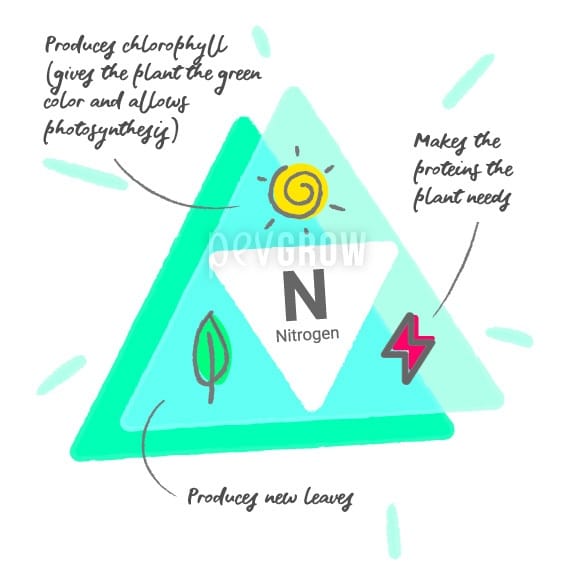
Remember, nitrogen is the main component for your plant to produce new leaves. Besides the root system, the cannabis canopy is crucial for the survival of your cannabis plant. The leaves are the engine, the light is the fuel, and the chlorophyll is combustion. Nitrogen allows for all of these critical components to happen, so it’s with the utmost importance that you take the time to understand and respect the role of nitrogen fully.
🎯 Feeding Cannabis Nitrogen
If you’ve grown weed, then you’ve seen all the cannabis nutrient products and their display of the macronutrients N-P-K. N stands for nitrogen, the other two are phosphorous and potassium, but we’ll focus on the other two in another series.
As your cannabis plant begins to grow and uptake nutrients, the available supply of nitrogen will decrease. This means that you’ll need to feed your cannabis plant nitrogen continually. Of course, the type of nitrogen you feed your plant is dependant on the method in which you’re growing.
The most straightforward method is to buy nutrients that are considered “safe.” This means that buying a bottle of plant fertilizer that consists of an N-P-K of 10-10-10 is generally a safe standard. The reason for this is because all marijuana strains have different nutrient needs, and a gentle 10-10-10 ratio is best for starting out.
Nitrogen is quickly absorbed through cannabis, and you’ll notice fairly quickly if you gave too little or too much. Let’s take a look at identifying problems related to nitrogen.
👾 Nitrogen Deficiency
Nitrogen deficiency has to be one of the most common problems that growers face. Suddenly your marijuana plant is turning yellow. You don’t understand why the lower leaves are beginning to wither and die off, but you do see it as a problem. Before you go throwing more plant nutrient, stop and identify the problem.
It’s common that growers do more harm than good when they blindly start adding things to their cannabis crop without first identifying the issue at hand.
The biggest giveaway for nitrogen deficiency is the yellowing of lower leaves. The reason this occurs is that the plant has run out of available nitrogen to uptake. This causes higher leaves that are closer to the light to steal the lower leaves’ nitrogen. If left alone, the lower leaves will eventually fall off, and the problem will continue from bottom to top until the plant cannibalizes itself in search for nitrogen.
You’ll know if your plant is recovering if the yellowing doesn’t continue and leaves begin to regain their healthy green shade. Light green is always a sign that a nitrogen deficiency is close to happening.
The worst time for a nitrogen deficiency is at the beginning of the vegetative stage, where the plant is focusing on growing foliage that will help once the flowering stage begins. Alternatively, it’s at the end of flowering that growers tend to intentionally create a nitrogen deficiency to rid the plant of chlorophyll.
Now that you’ve identified the problem, increased the dosage of plant nutrient, you should wait a few days to confirm if your plant is recovering. Remember, patience is half the battle when it comes to growing marijuana.
The Only Time You Want a Nitrogen Deficiency
There is, in fact, a time when you actually do want a nitrogen deficiency. The only time you’ll ever want this as a marijuana grower is during the end of the flowering stage. Depending on the strain, you want your cannabis leaves to turn yellow around week 8-10 of flowering.
But why? This is a situation that is very specific to growing marijuana because it all has to do with the end product. You guessed it- it has to do with the buds that we’ll eventually smoke after the drying and curing process.
Chlorophyll as we learned, is the necessary pigment in absorbing light. Near the end of the flowering process, we’re going to sadly kill our plants to harvest them. The issue with chlorophyll is that this pigment as contains a smell similar to hay or dry grass, which we taste when smoking the finished product
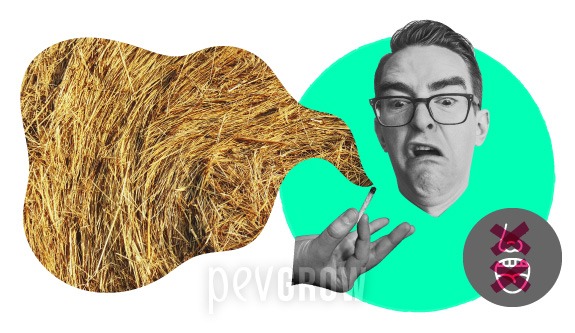
The easiest way to get rid of this smell and taste is by flushing out as much of the chlorophyll as possible. Growers will usually start only watering their plant with small amounts of nutrient to force a nitrogen deficiency. This is extremely apparent when you look at pictures of growers harvesting their plants. What you’ll see is large buds and most of the leaves a bright yellow color.
This isn’t an essential step because you can also get rid of excessive chlorophyll during the drying process. All you’ll need to do is leave your plants in complete darkness for a few days to speed up the dissipation of chlorophyll from the leaves.
⚠️ Nitrogen Toxicity
The opposite of a nitrogen deficiency is when we see nitrogen toxicity. This is equally as common as nitrogen deficiency because new growers tend to overdose their plants with nitrogen. It’s a fact that new growers kill their cannabis plants by loving them too much.
It’s common that growers cause nitrogen toxicity by following even the recommended dose found on their nutrient product. The recommended dose offered by nutrient companies is just a general amount because some strains will need either more or less. Once again, no strain is created equal, and this means that each strain you grow will more than likely require varying dosages of nutrient.
When encountering a nitrogen toxicity issue, you’ll see a deep shade of green on the leaves of your marijuana plant. The deep shade of green can worsen and even take on a slight deep blue hue in extreme cases. This is a very noticeable symptom and is therefore easy to identify and fix before real damage occurs to your cannabis plant..
Another noticeable symptom of nitrogen toxicity is called the “claw.” The ends of the fan leaves will point down, similar to the way a bird claw looks. This symptom is also present when overwatering cannabis plants, but if you’re not overwatering, then this should lead you to believe that you’re amid a nitrogen toxicity issue.
To add to the list of symptoms is also leaf tip burn. When too much nitrogen is added, the plant tries to get rid of it through the ends of the leaves. This results in the leaf tips looking necrotic and seemingly burned.
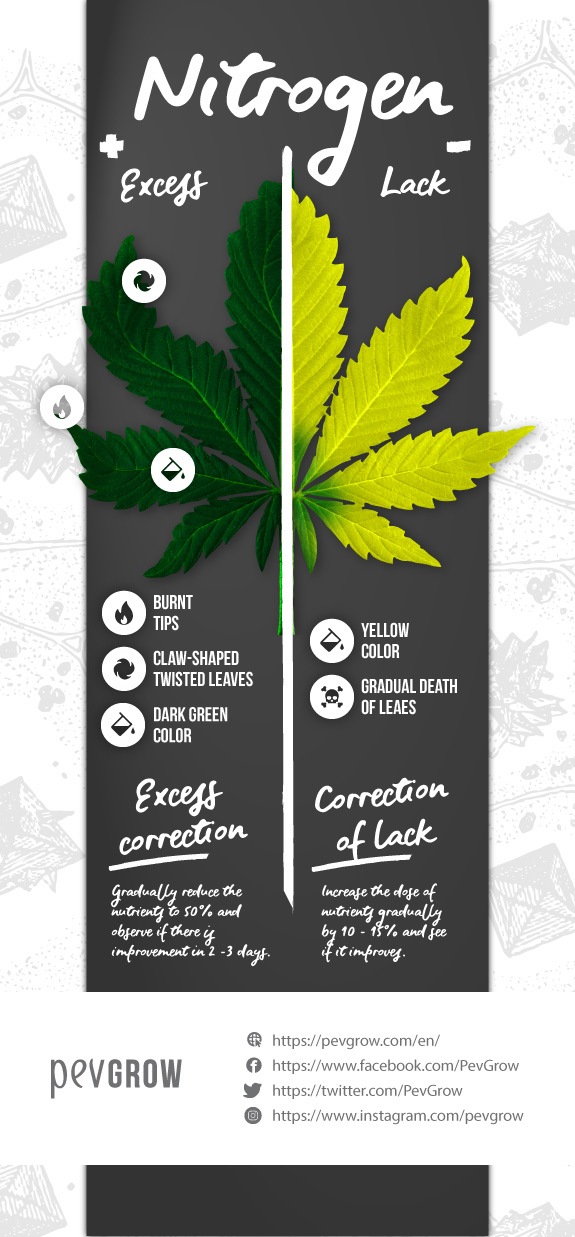
If nitrogen toxicity is allowed to continue,then the plant will cease many necessary functions to sustain vigorous growth. You should never let a toxicity issue to gain a foothold on your plants because it will result in a more extended recovery period.
It’s dangerous to suddenly stop giving nutrients when noticing a nitrogen toxicity issue because the plant is still up taking the other necessary nutrients. If you stop giving nutrients, you may find yourself in the exact opposite situation: a nitrogen deficiency!.
Small steps are vital in not creating a bigger problem. Adding or decreasing nutrients will take a few days to show results.
🔥 The Role of pH and Nitrogen Issues
As we all know, there are a host of problems that can go wrong while we’re growing our marijuana crops. A major complicating factor for nitrogen toxicity or deficiency is when it’s accompanied by pH issues.
Depending on the medium that we’re growing in, pH plays a vital role in the health of our plants. This is extremely apparent when growing in hydro or aeroponic systems. These systems don’t have the natural buffer found in soil-grown plants. Cannabis grown in soilless systems rely on their caretakers to set the pH to a correct level that allows the plants to take up plant nutrient effectively.
If you don’t set the pH to a correct level (usually 5-6pH), then you’ll compound your problems as you see deficiencies or toxicities starting to mount up. The root zone doesn’t enjoy the wrong pH and will stop taking up nitrogen, thus creating a nitrogen deficiency.
📖 Conclusion
These are just a few examples of the intricacies of growing marijuana. Most aspects of the plant are interconnected, which leads to one problem affecting another portion of the plant.
For marijuana plants to develop smoothly, the pH and dosage must be continually monitored.

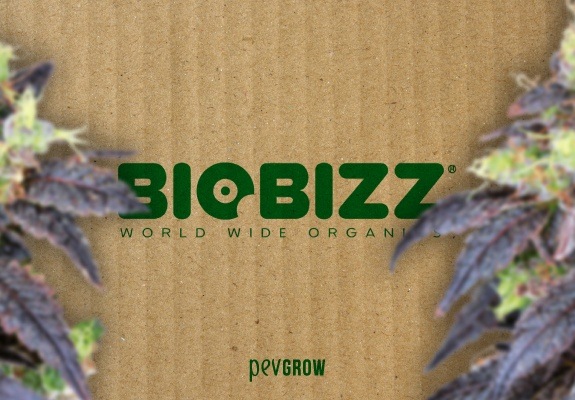
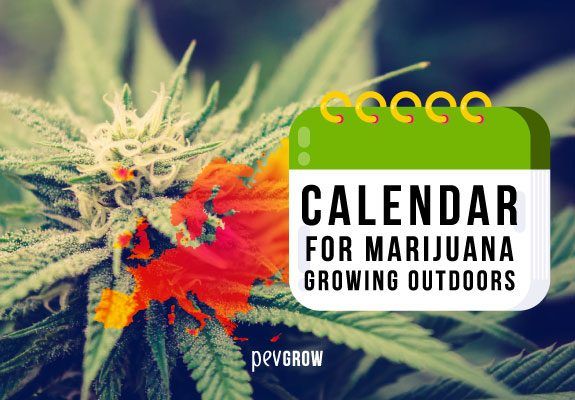
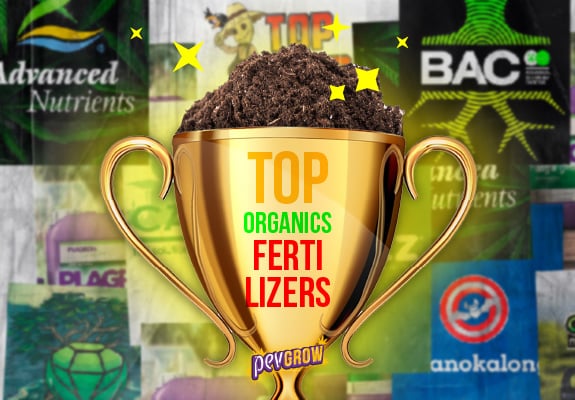
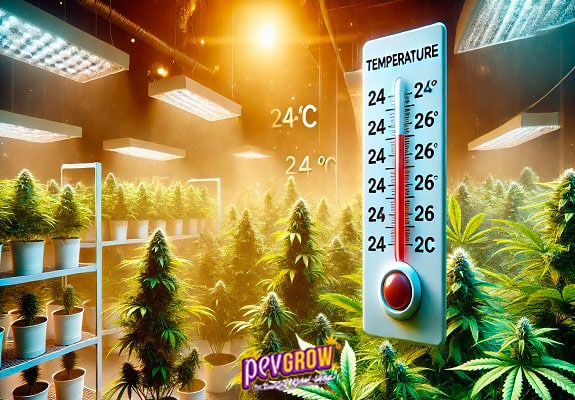

Great info!
ive been scouring the web for a side by side analysis of nitro toxicity vs def. all of the big named sites only show one or the other. never really explaining the differences in them, nor do they explain that other deficiencies mimic this. Thank you for the info!!!! Much love from oklahoma.
Hi Trae!
Thank you for your words! 💚
Hello,
Should I decrease just the A part of my nutrient by 50% or decrease my entire nutrients by 50%. Thank you!